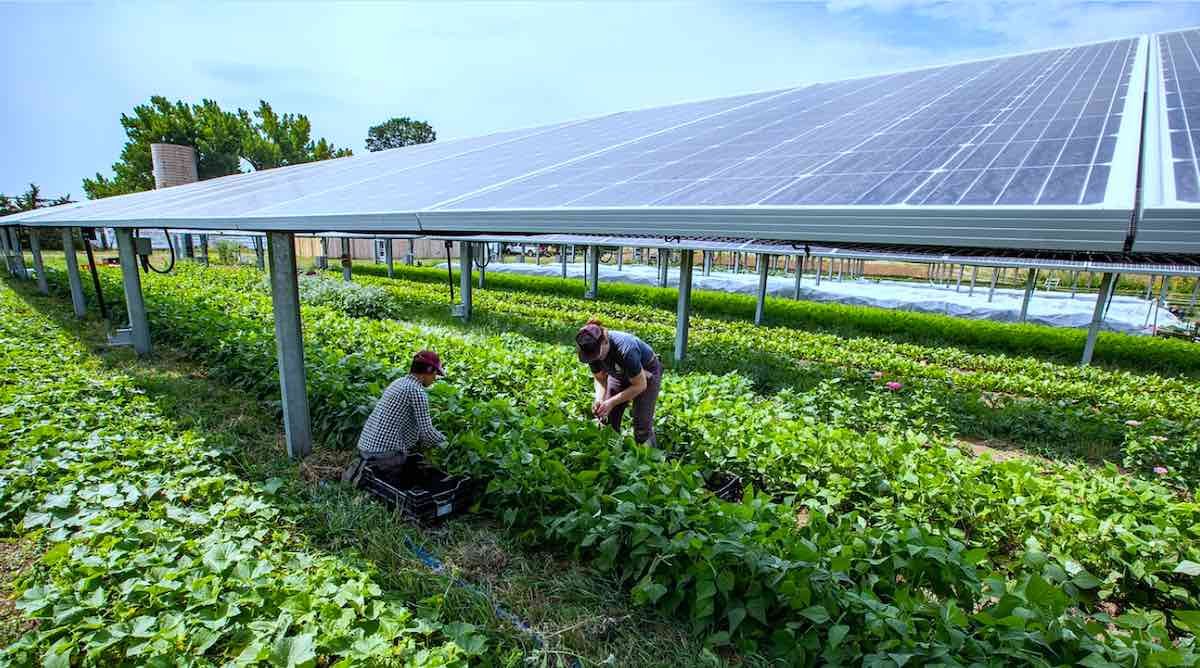Largest Farm to Grow Crops Under Solar Panels Proves To Be A Bumper Crop For Agrivoltaic Land Use::undefined
As this is not mentioned, is it possible to extend the system by collecting rainwater falling on solar panels ?
The rainwater would fall off the slanted panels and fall onto the plants.
This is so cool!
I guess it would depend on the crops, but wouldn’t it somewhat limit the use of farming equipment. I assume you’re not going to fit a tractor in the field with those panels and supports.
The original story from NPR says that they’re able to drive their tractor between the panels. It’s interesting that the project could essentially be described as an end run around a historic designation though. They put 1.2 MW of solar up, and from reading between the lines it seems that’s how they’re making money, the farming seems to be much more of a side thing that they’re required to do for historic reasons.
It’s usually permanent pasture grazing that’s mixed with solar panels. Take low value land that doesn’t support the use of large equipment, add value with panels and get free shade for livestock.
It depends on the type of supporting structure for the panels. In Germany a company built it tall enough to use their normal farm equipment: Image
I’ve seen pictures of massive tractors pulling several ploughs side by side in the US, that would most likely not work with this, but there are plenty of solutions for anything on a slightly smaller scale.
There’s lots of startups making smaller agile AI powered electric robotics for agriculture. Would pair well with a farm like this.
This seems to largely be a “retelling” of an original story from NPR from 2021. The original has significantly more information from actually interviewing the owner of the project.
Agro-solar is a win win. Solar is the fastest and the most economic energy to deploy.
Start putting solar canopies over all these goddamn mostly empty parking lots we have everywhere. Completely wasted space otherwise and it’d provide some cover from the rain for people coming and going from their cars.
Or abandon the min parking reqs so developers can build something else there. But also solar panels where we actually need parking space
Most of those minimum parking requirements are based on bullshit anyways.
Yeah, build something other than a parking lot, and put a solar panel on top of that! 🧠
This is one that seriously gets me as to why we don’t do this more, it would make so much sense. Obvious benefits are power generation, but also when you consider, it would significantly reduce how scorching hot large carparks get in the sun, depending on the style of the solar canopy being built it could also massively reduce the amount of water flow onto the ground reducing some wear on the tarmac in addition to some hazards.
Also for places like the UK where we typically don’t have huge amounts/extended periods of snow, as long as the canopy is sufficiently designed for the additional weight, you could ameliorate the need to salt the car parks, once again increasing the life of the tarmac.
It would also keep people’s cars much cooler, in the sun, and make things generally a lot cooler below the canopy.
Plus you’d lower the temperature of the vehicles, reducing air conditioning and decreasing fuel/battery use, which would further decrease emissions
No one ever brings this up, but the heat island effect might be diminished? Not sure how the math works out there.
Possibly? But either way, cooling the panels will increase their service life with a slight net increase in output as well. It should reduce the heating of parking lots by as much of the power it makes.
Possibly a stupid question, but is there anything toxic in the solar panels or their infrastructure that could contaminate the plants or soil below? Particularly if the panels were damaged in, say, extreme weather, but also as a result of general wear and tear. I’m thinking heavy metal dust, carcinogenic liquid components, that sort of thing. As per the article this seems like it could be a good land use pairing, but not if it renders the soil unfit for agriculture due to a buildup of contamination.
Not an expert, but my gut reaction is not really. The panels themselves are largely glass, aluminum and silicon, with fairly small amounts of doping agents. There are electronics but since they’re outside they’re largely encased in something, wiring which would be plastic and copper or possibly aluminum, and then the structure itself which is going to be steel and concrete.
Solar panels are significantly more sturdy than one would think given they are essentially a giant piece of glass. They’re usually rated to 12mm hail or more, which would normally absolutely devastate a crop. They don’t really go bad either they just become less efficient over time. There’s no moving parts to wear, no liquids, and in some designs very little in the way of electronics to go bad.
Essentially, I wouldn’t be surprised if there would be more harmful contamination from a diesel tractor driving around in the field or from a nearby coal power plant than from any kind of solar array as long as it didn’t have like, lead legs or something.
That being said, these kind of projects have been shown a lot but they’re unlikely to be used in most large scale farming - they usually interfere with any machines used to plant or harvest, and are only really well suited to a few crops. Parking lots are a much easier target for this type of solar project.
I’ve heard of the panels burning down making fhe field unsafe for use in the future
That’s not a thing.
most electronics have lead, i think thatd be the main thing .
Not really. Not for the last 20 years.
https://en.wikipedia.org/wiki/Restriction_of_Hazardous_Substances_Directive





